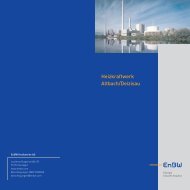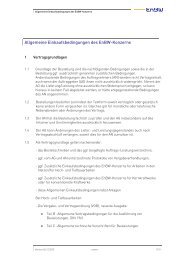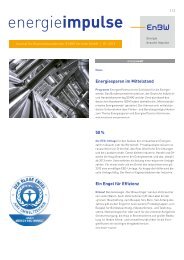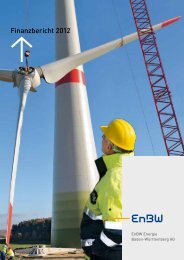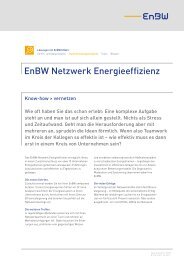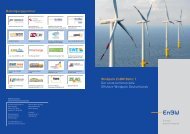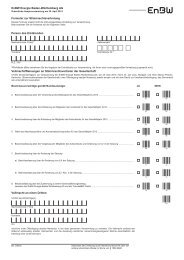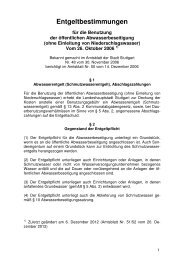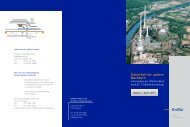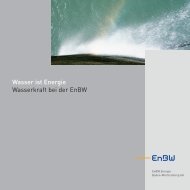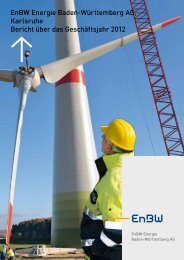Environmental Report 2000 - EnBW
Environmental Report 2000 - EnBW
Environmental Report 2000 - EnBW
Create successful ePaper yourself
Turn your PDF publications into a flip-book with our unique Google optimized e-Paper software.
State of the Environment <strong>Report</strong><br />
Regular appraisal of suppliers<br />
The operating locations with eco-certification<br />
regularly check the quality<br />
standards of our suppliers. Safety<br />
data sheets for hazardous substances<br />
are posted on our intranet. In-company<br />
regulations governing the hand-<br />
By replacing an old coal-fired unit in<br />
the Rheinhafen steam power plant at<br />
Karlsruhe with a state-of-the-art gas<br />
turbine and steam unit, we have<br />
increased output efficiency to 57.5%<br />
– a record figure for Germany.<br />
In the Philippsburg nuclear power<br />
plant (KKP), we were able to increase<br />
output efficiency first by 116 MW and<br />
then by a further 34 MW without<br />
recourse to added fuel consumption.<br />
We did this by firstly replacing the turbine<br />
blades between 1991–1996 and<br />
then, with official sanction, by raising<br />
the middle range cooling agent temperature<br />
in unit 2 in <strong>2000</strong>.<br />
24<br />
ling of hazardous substances will be<br />
posted in the intranet in 2001.<br />
The fuels used in our power plants<br />
are coal, heating oil, gas, uranium,<br />
sewage sludge and wood. We regularly<br />
monitor both the quality of the<br />
fuel and its history from extraction to<br />
final delivery.<br />
Maximum efficiency with minimum resource consumption<br />
When building new installations we opt for energy-saving construction. And we have<br />
continually improved the efficiency rating of our power stations.<br />
Energy-saving in offices too<br />
In view of the 4% of energy used in<br />
energy production and the further 6%<br />
of inevitable loss during transport and<br />
distribution, energy savings in our<br />
administrative departments play a<br />
negligible role in the overall picture.<br />
Even so, this is an area in which we<br />
are also highly energy-conscious.<br />
We are careful to see that new photocopiers<br />
and other office equipment<br />
comes complete with automatic<br />
power-down devices, that office lighting<br />
can be controlled by movement<br />
sensors and only uses energy-saving<br />
bulbs.<br />
Auxiliary material for power production in t<br />
Limestone<br />
38,933 t<br />
85%<br />
In particular, our certificated sites are<br />
the focus of systematic monitoring<br />
measures that seek to pinpoint energy-saving<br />
potential and harness it to<br />
environmental programmes. This includes<br />
a wide variety of measures<br />
from the optimal use of pumps and<br />
plants to enhanced control of electric<br />
motors.<br />
During conversion, we equip our<br />
buildings with energy-saving insulation.<br />
And if the findings of cost benefit<br />
analyses are positive, we take steps<br />
to install heat recovery units.<br />
9%<br />
3%<br />
3%<br />
Hydrochloric<br />
acid<br />
1,223 t<br />
Ammonia<br />
4,142 t<br />
Other<br />
1,300 t<br />
A miserly approach to water<br />
We are constantly striving to reduce water consumption by introducing water saving<br />
measures and multiple applications.<br />
Operating a power plant requires a<br />
tremendous quantity of water. This<br />
water isn’t actually consumed, but<br />
merely heated with the waste heat<br />
and channelled back into the river. In<br />
many sites ecological problems can<br />
be avoided by the use of cooling<br />
towers so that river heating is kept to<br />
a strict minimum.<br />
The partial conversion of units 3-6 to<br />
cold reserves in the Heilbronn thermal<br />
power plant has significantly reduced<br />
the need for cooling water and thus<br />
the warming of the river Neckar.<br />
Waste water recycled and<br />
recycled…<br />
In the past few years we have realised<br />
concepts for the multiple use of<br />
waste water in our plants at Heilbronn<br />
and Karlsruhe and in our treatment<br />
and disposal installations. These<br />
concepts have led to a drastic drop in<br />
levels of fresh water consumption.<br />
They will be further developed.<br />
Whilst river water consumption in our<br />
three thermal power plants at Heilbronn,<br />
Karlsruhe and Philippsburg has<br />
dropped by 40% from its 1997 level<br />
of 3 billion cubic meters to 1.8 billion<br />
cubic meters, the level of drinking<br />
water consumption has fallen by half.<br />
Water Input: River Water<br />
in million m 3<br />
3,500<br />
3,000<br />
2,500<br />
2,000<br />
1,500<br />
1,000<br />
500<br />
0<br />
3,059.44<br />
1997<br />
River water<br />
2,189.36<br />
1998<br />
2,306.14<br />
1999<br />
1,790.42<br />
<strong>2000</strong><br />
In Heilbronn our ground water consumption<br />
has increased due to the<br />
increased water levels in the storage<br />
building. We use the water for plant<br />
operations and divert the rest, which<br />
is more than we need, into the river<br />
Neckar.<br />
Water Input: Groundwater/Drinking Water<br />
in million m 3<br />
3.5<br />
3.0<br />
2.5<br />
2.0<br />
1.5<br />
1.0<br />
0.5<br />
0<br />
0.138<br />
2.56<br />
0.141<br />
2.71<br />
1997 1998 1999<br />
Drinking Water<br />
Groundwater<br />
0.09<br />
3.01<br />
0.07<br />
3.27<br />
<strong>2000</strong><br />
25



